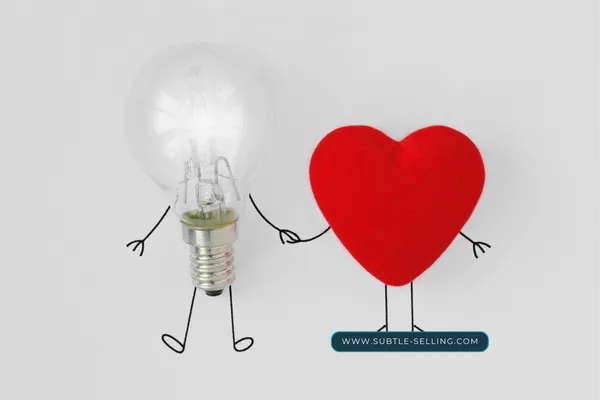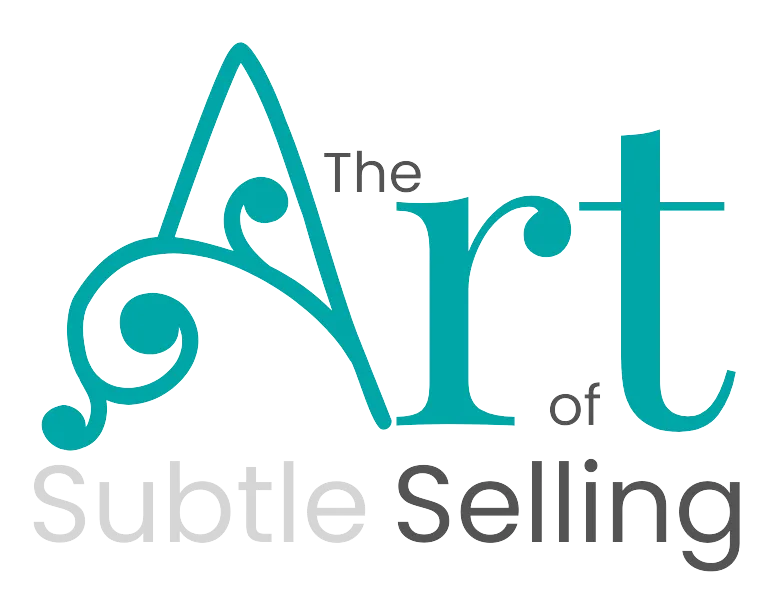
How to Sell with Empathy (Without Letting it Hold You Back)
Can I be real with you for a minute? If you’re an empathetic seller, you’ve likely had moments where you held back during a sales conversation. You wanted to make the sale buuuuut… you didn’t want to seem pushy, more. You felt your client’s hesitation and thought, ‘Maybe they’re not ready. I don’t want to pressure them,’ and backed off so far you didn’t even tell them the price. (ask me how I know!)
That’s the thing about being empathetic. You're a nurturer. You want to create a comfortable space for your prospects, so you hesitate. You might find yourself holding back from discussing price, or feeling emotionally drained after sales calls, or even just focusing so much on their hesitations that you forget to guide them toward a decision. And maybe that makes you feel like you should stuff that empathy right in the trash because it doesn't have a place in sales...
But before you do that, I want you to know something: Empathy is actually your superpower in client-centric sales. No, really!
Your empathy is what makes your prospects feel so comfortable. It’s why they lean in. It’s why they say things like, “I love how easy you are to talk to,” or “You’re not like other salespeople.” Your empathy is good for them.
But without some structure around your empathy, it may it not be great for you; without structure it can become your biggest sales blocker. You might tend toward over-explaining, absorbing every hesitation like a sponge, or waiting for your prospect to make the first move. And guess what? They rarely will.
That’s why today I want to dive into how to sell with empathy while leading with confidence. I want you to be able to be your authentic, empathetic self, while still guiding your clients toward the best decision for them.
How Empathy Gives You a Natural Sales Advantage
Your ability to connect with prospects on a deep level is what makes you stand out from the stereotypical pushy salesperson. You’re not just selling a product or service—you’re helping someone solve a real problem.
Think about it like this: Imagine you’re a tour guide leading a group through a jungle. Some guides rush ahead, not checking to see if everyone’s keeping up. Others constantly stop and wait for the group, afraid to push forward. But the guide people trust to get them safely to the other side of the jungle? They check in, make sure no one’s lost, and confidently lead the way. That’s you, when you can strike the right balance between empathy and leadership because:
🔹 You make clients feel heard and valued. They trust you because you actually listen instead of just pitching.
🔹 You pick up on concerns early, which means you can address them before they turn into full-blown objections.
🔹 You naturally build long-term relationships. Clients want to work with you again and again because they feel respected, leading to more referrals and repeat business.
But here’s where it gets a little sticky. It’s a balance. If you lean too hard into the emotional connection without being the guide, your sales conversations will stall. If you lean too hard on the structure, you risk alienating your prospects.
So, I don’t want you to trash the empathy, I want you to balance it with leadership. You are the subject matter expert on the solutions, they are the subject matter expert on the problem.
Instead of resisting your nurturing nature, let’s talk about a subtle shift that can, hopefully, help you embrace it and see it for the superpower it is, while still helping you close more sales.
The Mindset Shift: Selling = Helping, Not Convincing
Let me start by saying I don’t subscribe to the “always be closing” approach to selling or it’s emotionally manipulative tactics. You’re not here to convince someone to buy from you. You’re here to help them see if your offer is the right fit for them. They’re looking for some leadership.
Think about it like this: Imagine your friend is searching for the perfect jacket to take on a hike in the Appalachians. They think they just want something to keep them warm, that also looks cute, and they can’t decide between two options at the store. If you know one of the jackets is waterproof, and has a warranty against tears, wouldn’t you speak up?
Selling works the same way. Your role is to guide them, not just listen to their doubts.
✔️ Selling is a service. If they have a need, your role is to help them solve it. You’re not being pushy, you’re being helpful.
✔️ People don’t always know what they need. They may think they do, but they don’t have subject matter expertise on the solution. They need your guidance to recognize the right solution for them that ticks all the boxes – even the ones they didn’t realise were on the list.
✔️ Confidence creates clarity. When you confidently present your offer, especially after demonstrating you care, it reassures them they’re making a smart choice.
That’s what I mean by leadership in sales conversations. And empathy without leadership creates confusion. But empathy with leadership builds trust and drives action.
So how do you bridge that gap and create space for hesitation, while still moving forward, and not feel pushy?
3 Ways to Handle Hesitations Without Feeling Pushy
Hesitation is a natural part of the decision-making process. It doesn’t always mean a prospect isn’t interested. It often means they’re weighing their options, considering potential risks, evaluating their belief in their ability to commit, or sometimes mentally moving money from one commitment to another to make this investment possible!
Instead of internalising hesitation as rejection, I want you to reframe it as an opportunity to be in service. To guide them toward greater clarity. Remember, your role isn’t to convince them, it’s to help them see whether this is the right step forward for them.
When a prospect hesitates, a lot of empathetic sellers immediately back off instead of leaning in. Their fear of harming the relationship takes over and causes them to take a metaphorical step back.
I’m suggesting that reframing the hesitation in your heart as an opportunity to be in service gives you courage to be their guide. Instead of reinforcing their doubt, you use your natural empathy to guide them forward.
Here are some concrete examples of how you can do that:
Acknowledge the hesitation—without reinforcing doubt.
❌ “I totally get why you’d hesitate—maybe this isn’t the right time for you.”
✅ “I hear that you’re unsure. Let’s talk through what’s on your mind.”
Ask guiding questions instead of over-explaining.
❌ “Maybe I didn’t explain it well enough—let me give you more details.”
✅ “What’s on your mind right now? Let’s unpack it together.”
Let them own the decision.
❌ “I really think this would be amazing for you.”
✅ “You know yourself best. If this feels like the right choice, why don’t we start the process.”
See the difference? You’re still guiding them—but you’re doing it with confidence, not pressure.
How to Stop Taking Objections Personally
Alongside hesitations are outright objections. If you’ve ever felt like an objection was a personal rejection (“They don’t believe in me.”), let’s rewrite that inner bully right now. Objections aren’t usually about you. They’re a product of the client’s internal decision-making process.
Here’s how to detach emotionally and respond with confidence:
🔹 Expect objections, they’re normal even when you've done all the right things to prevent as many as possible. Even master salespeople sometimes hear “no” before they hear “yes.”
🔹 Ask instead of assuming. Instead of thinking, ‘They must not be interested’, ask, "What’s on your mind, right now, as you consider this?"
🔹 Give them space to process. Silence isn’t a bad thing; it’s a sign they’re thinking. Different people process at different speeds. Let them percolate their decision without you trying to jump in to “fix” it.
I know it may sound hard. And it may be hard at first. With practice it gets easier. And it's worth the practice because when you can stop taking objections personally, you will stop over-explaining, over-apologizing, and you’ll start selling with quiet confidence.
Recap: Lead with Empathy, Sell with Confidence
Your ability to connect with people is your biggest strength, but your clients also need your leadership on this journey to solving their problem.
✅ Reframe selling as helping, not convincing.
✅ Guide hesitations with confidence, not fear.
✅ Detach from objections and trust your process.
When you balance your empathy with your leadership, you won’t just sell more effectively, you’ll create a sales experience your clients actually enjoy.
By incorporating these reframes, you’ll still sell with heart - without letting it hold you back. 💙
Danielle 🤘🏼
Recommended for You:
📖Integrity Selling: How to Sell with Honesty & Trust – Learn how to balance transparency with selling.
📖 The Secret to Leading Clients to a Yes – How to guide conversations toward confident decisions.
📖 How to Handle Objections Without Feeling Awkward – A deeper dive into responding with confidence.
📖 Why Clients Hesitate—and How to Move Them Forward – Understanding buyer psychology to reduce hesitations.
Audio Trainings & Insights
Listen to My Audio Trainings
Click play to gain insights on The Subtle Art of Selling.
Preventing Objections & Empathy Opening
Solopreneur Summit
Screeing Vs Qualifying in Sales
The Flamingo Podcast
Getting Comfortable with the Unknown
Chaos to Clarity Podcast 2024
Want more? Check out my full training library on YouTube! @artofsubtleselling

